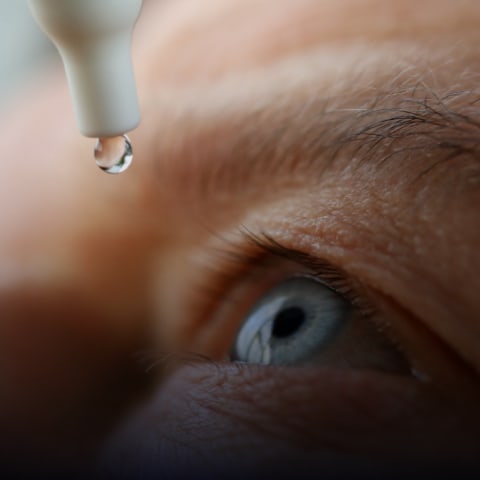Irritation, burning, and stinging are some of the discomforts experienced by dry eye sufferers. And if you happen to be someone who relies on contact lenses, dry eye symptoms can make contact lens wear challenging. But you don’t need to compromise on clear vision and comfort.
Contact lenses such as daily disposables, silicone hydrogels, and scleral lenses can help minimize or, in the case of scleral lenses, alleviate dry eye symptoms and make wearing contact lenses comfortable, convenient, and customizable. A contact lens exam and fitting can help you find contacts for your eye health, determine the right prescription for vision clarity, and update your existing prescription.
What Is Dry Eye?
Dry eye is an ocular surface disease that happens when the eyes can’t maintain a proper layer of tears to protect the eye’s surface. When the eyes fail to produce sufficient or quality tears, the lack of lubrication and the faster evaporation of tears can lead to dry eye and significantly impact daily life and quality of vision. Common dry eye symptoms can include the following:
- Redness
- Stinging
- Burning
- Grittiness
- Scratchiness
- A foreign feeling in the eye
- Excessive tearing
Dry Eye Causes
There are various causes of dry eye, such as:
- Aging
- Environmental factors
- Medical conditions
- Medications
- Genetics
- Long-term contact lens wear
Challenges for Contact Lens Wearers
Contact lenses float on the tear film layer of the eye and over the cornea (the transparent front layer of the eye). However, this equilibrium can be disrupted in those who experience dry eye, leading to discomfort.
Traditional contact lenses can exacerbate dry eye symptoms by absorbing whatever tears are in the eyes, further drying out the eyes. For contact lens wearers, factors such as lens material and the tear film interaction are essential to consider.
Factors to Consider When Choosing Contact Lenses
Selecting the right contact lenses is not a one-size-fits-all process, as it’s a highly individual decision. Your optometrist can help you consider the following factors when choosing comfortable and effective lenses for dry eye management.
Comfort & Moisture Retention
Lenses that maintain moisture and offer a comfortable wearing experience are essential for dry eye relief. Look for lenses designed with moisture-retaining materials or with a high water content. Comfort should be a primary focus as you explore your options, especially if you have had discomfort with previous lenses or have dry eyes.
Oxygen Permeability
High oxygen permeability is necessary for eye health, but it can also improve the comfort of contact lenses for dry eye sufferers. Make sure your lenses allow enough oxygen to pass through to the cornea.
Lens Material & Design
The lens material plays a critical role in preventing dry eye symptoms. There are various soft lens materials available, each with its own moisture retention and oxygen transmission properties. The design can affect how the lens sits on the eye and interacts with the tear film.
Types of Contact Lenses for Dry Eye
To combat dry eye discomfort, specialized contact lenses have been developed with innovative materials and designs to address the unique needs of dry eye patients.
Daily Disposable Lenses
Daily disposable contact lenses offer a fresh, clean lens each day, which can be particularly beneficial for those with dry eyes. Since you replace daily disposable contacts regularly, there is less time for protein and lipid deposit buildup, which can lead to discomfort in dry eye sufferers. These contact lenses also eliminate the need for a cleaning routine, reducing the risk of irritation caused by contact lens solution.
Silicone Hydrogel Contact Lenses
Silicone hydrogel contact lenses are known for their high oxygen permeability, which allows more oxygen to reach the corneal surface. This feature is vital for users with dry eyes, as it helps to maintain eye health. Silicone hydrogel contact lenses also retain moisture, making them a preferred choice for many people with dry eyes.
Scleral Lenses
Scleral lenses are more rigid than standard contact lenses and vault over the cornea, resting on the sclera (the white of the eye). The design of scleral lenses leaves a space between the lens and the cornea, filled with a cushion of saline solution, which can act as a reservoir. Scleral lenses can be effective for people with severe dry eye symptoms and corneal irregularities.
Tips for Managing Dry Eye While Wearing Contact Lenses
Even with contact lenses for dry eye, you still require proper lens care and hygiene practices. If you’re not using daily disposables, proper cleaning and care of your contact lenses are essential to prevent any additional sources of irritation. Use the recommended contact lens solution and follow a strict hygiene routine per your eye doctor’s recommendations.
Find Contact Lenses for Dry Eye Relief
Finding the right contact lenses for dry eye can take time and patience. When you work closely with your eye doctor, they can help determine what type of contact lenses can contribute to healthy eyes and vision for you.
Each individual’s eye and tear film is unique, and what works for one person may not work for another. Book an appointment with us at Sundre Eyecare, Carstairs Eyecare, Olds Eyecare or Bonavista Eyecare to find lenses that can help you enjoy clear and comfortable vision.


































